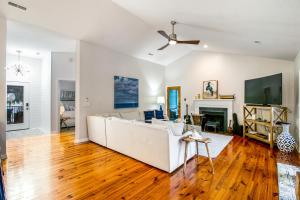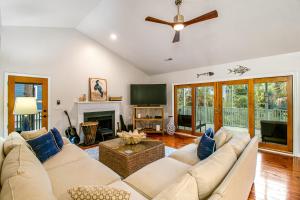Mentioned by Explore Charleston Blog
10 Must-See Museums in Charleston


"Along a one-mile section of Meeting Street you will find 6 museums, 5 nationally renowned historic houses, 4 scenic parks, a Revolutionary War powder magazine, and an array of historic houses of worship and public buildings such as the Market and City Hall. To start planning your trip, simply click the banners on the map."
"Learn about Charleston’s role in the Revolutionary War or the Civil War. Browse engaging displays that capture the local social and cultural histories of the region. Wherever your interests lay, you’ll find plenty of fascinating exhibits at the Charleston Museum!"
"Celebrated as America’s first museum, this downtown institution masterfully interprets the cultural and natural history of the Charleston area with hands-on exhibits that include fossils, colonial clothing and more."

"Fort Sumter is a sea fort in Charleston, South Carolina, notable for the battle, which signified the start of the American Civil War. The Battle of Fort Sumter in 1861 was the bombardment of Fort Sumter by the South Carolina militia; the Confederate Army did not yet exist. The United States Army returned gunfire, but the fort had been cut off from its supply lines and surrendered the next day."
"When you’re looking for things to do in Charleston SC with kids, Fort Sumter is a no-brainer!. I love an activity where kids are learning and they don’t even realize it!. You and your family will learn about the history of Fort Sumter and the pivotal role it played in the Civil War, but I think it’s most fun for families to get out and explore the grounds of Fort Sumter."
"Join a fascinating boat tour to the historic Fort Sumter National Monument, set at the mouth of the beautiful Charleston Harbor. Enjoy a backdrop of Charleston’s stately waterfront homes, The Battery, and Rainbow Row. This fully narrated cruise departs from Aquarium Wharf at the South Carolina Aquarium."

"Listen to the haunting real stories and view original artifacts and writings in this striking historic building once used for slave auctions. The museum's legacy as a part of a slave auction complex built in 1859 provides a unique home for the moving artifacts and disturbing personal histories that tell the story of slavery beginning in American colonial times. Charleston was a major port of call for the Middle Passage avenue of slave trade nearly up until the end of the civil war."
"The only remaining structure from a complex of buildings known as Ryan’s Mart, where hundreds of slave auctions were held from 1856 to 1863, the Old Slave Mart Museum exhibits focus on the domestic slave trade from the perspectives of historically-documented buyers, traders, and enslaved African Americans, and speak to their stories, contributions and legacies."
"As you must have seen in movies or read in old stories, slavery was a common phenomenon in the countries ruled and lived in by the Whites’. This place is one such where the slaves were set for display. Yes, the name comes from the fact that this was a slave display gallery in earlier times."

"Colonial and Victorian styles were popular among architecture in Charleston during the pre-revolution war period between 1600s and 1700s. Today, Exchange and Provost, earlier known as Old Exchange Building, is an epitome of Colonial architecture with low foundations and 3 levels. Multi-pane windows, pillars, symmetrical facades and columns are found within the building."
"Year: 1767–1771 Architectural Style: Georgian Architect: William Rigby Naylor. About: The Old Exchange is located on the east side of Charleston’s historic downtown area, at the northeast corner of East Bay and Broad Streets. It is a two-story masonry building, capped by a hipped roof with cupola and set on a high brick basement."
"Old Exchange & Provost Dungeon is the most historical building in South Carolina which talks about patriots and constitutional ratification during colonial era. Built in Georgian architecture, the building focuses on the colonial Charleston and American Revolution with its structure and décor."

"The first of its kind in the state, the new South Carolina Historical Society Museum showcases 300+ years of state history through the personal artifacts, priceless treasures and hand-written accounts of those who experienced it. Combining interactive technology and hands-on exhibits with one-of-a-kind historical items, visitors get a firsthand glimpse into the lives of the people who created South Carolina’s history."
"South Carolina Historical Society Museum is an architectural museum which equips various interactive exhibits about places and historical movements of Charleston revolution. With 6 interactive galleries, museum is a historical landmark capturing the beauty and style of South Carolina in its sculptures, paintings and miniatures. Timings : 10:00 AM – 5:00 PM (Tuesday to Saturday)"

"The Avery Research Center for African American History and Culture, one of Charleston’s less commonly visited attractions, offers an interesting insight into the city’s educational and cultural history. The Center itself is located in a historic building formerly occupied by the Avery Normal Institute, operated from 1865 to 1954 as a segregated school for Black secondary students. Things to see include a recreation of a 19th-century classroom, rotating exhibitions based on the Avery Research Center’s collections, and rotating art exhibitions featuring works from local South Carolina artists and members of the African diaspora."

"Right in the heart of historic Charleston’s downtown, the Powder Magazine is one of the city’s oldest buildings. Built in 1713, it was once upon a time a storehouse for gunpowder, making it an important location for both British troops and loyalists and those colonists and soldiers who fought on the side of the new nation. After the war, as the Charleston landscape shifted, the small building remained standing, and served as—amongst other things—a print shop, a livery stable, and even a private wine cellar."
"The Powder Magazine, built in 1713, is the oldest government building in South Carolina. The building was used as an arsenal from 1713 to 1748 and was later used in the American Revolution to defend the city. Throughout its years, it has been used as a print shop, a livery stable, a wine cellar, and a carriage house."
"This is a museum operated under an association known as the National Society of the Colonial Dames of America. It is the oldest surviving public building of the United Province of Carolina. The museum was earlier on just a godown where the natives used to store their gunpowder supplies."


"After Colonial architecture came Georgian architecture: square and symmetrical façades with five windows across the front, chimneys, and a centered front door with crown moulding. This style quickly swept the South – Georgian-style plantations began to pop up around town – and many homes followed suit. The Heyward-Washington House, built in 1772, was home to Thomas Heyward, Jr., who signed the Declaration of Independence; it was rented to George Washington during his stay in May 1791, the reasoning behind its name, ‘Heyward-Washington House.’ It opened in 1930 as the town’s first historic house museum, featuring a 1740’s kitchen open to the public, formal gardens with late 18th-century plants, and a collection of historic locally made furniture such as the Holmes Bookcase."
"As the name hints, this 1772 Georgian-style town house is kind of a big deal because George Washington rented it for a week, and visitors can stand in what was likely his bedroom. The owner, Thomas Heyward, Jr, was one of South Carolina's four signers of the Declaration of Independence, and it's fun to think about all the talk of revolution that must have taken place in the withdrawing room."



"This "Italian cafe and dessert bar" on East Bay Street is conveniently located close to dozens of popular restaurants and bars, making it the ideal post-dinner date dessert stop. Visit Carmella's for Italian treats and sweets, including cannolis, tiramasu and Italian ice, among other daily specials. This restaurant is dedicated solely to desserts, sweets, and baked goods, so dessert lovers may return more than once during their visit to Charleston!"

"The self-proclaimed luxurious wellness retreat does NOT disappoint. It’s the newest spa in Charleston and it came to wipe out the competition with a full list of relaxing services. They offer eight different massages and three different massage enhancements including CBD balm for all those currently obsessing over CBD oil and the amazing benefits."

"After you explore the global brand stores on King Street, hop into Spa Adagio at the iconic Francis Marion Hotel, known for playing relaxing sounds and filling their posh service lounge with sweet aromas. Using world-class skincare products from Image Skincare and Babe Lash, they offer a full slate of rejuvenating natural herb treatments, innovative detoxifying and cleansing body therapies. Whether it’s a fun date night or an exciting party, Spa Adagio preps you up gorgeously for your next adventure."
"The Spa Adagio at The Francis Marion Hotel is located in the hotel's lower level, conveniently situated close to nearby parks, museums, shopping and Upper King Street restaurants. Duck into Spa Adagio, whose name means 'slowly, leisurely, gracefully', for a quick nail care treatment or wax, or instead dedicate a full morning or afternoon to this spa's menu of services. Spa Adagio offers Massage Therapy at $55 for 30 minutes, $95 for 60 minutes and $135 for 90 minutes."
"This full-service day spa is located in the Francis Marion Hotel across from Marion Square in downtown Charleston. A day at Spa Adiago will leave even the most stressed person feeling rejuvenated and renewed. Some of their services include full body massage, aromatherapy, wrinkle lifts, facials, wraps, lash lift, and so much more."

"That's the message, and the mission, of the staff, services and organic boutique at Sweet 185. Conveniently located on Upper King Street, Sweet 185 is Charleston's pioneer sugaring studio. Head to this eclectic day spa for an alternative to your typical wax, in the form of a sugaring treatment."

"The Mary Martin Gallery of Fine Art was named one of the top 25 art galleries in the nation by the American Art Awards. The same organization awarded it the Best Gallery in South Carolina in 2016. The sculptures and painters on display here are diverse, spanning all genres and mediums."

"As well as a 3,600-square-foot ceramics gallery open to the public throughout the week, Cone 10 Studios offers classes and workshops in the various art forms which are on show and produced on-site. The porcelain and stoneware comes in traditional, functional forms which can be bought for your home or kitchen, and also in more conceptual, abstract forms which are both thought-provoking and aesthetically pleasing. Weekly classes are held in wheel-throwing, hand-building and teapot-making, in addition to a dedicated children’s program."
"Located in the Council Chamber of Charleston City Hall (1801), the gallery contains portraits of many important leaders, including one of George Washington by John Trumbull."

"Nestled in the College of Charleston, Halsey Institute of Contemporary Art aims at encouraging budding and experienced artist to explore and take their artistic acumen to a new level. This art gallery in Charleston is a non-profit organisation that focuses on specific subjects by actively participating in events and holding programmes where it sets a common stage for discussion through lectures, films, panels and symposia. The subjects of discussion mainly revolve around history and culture."
"The Halsey Institute of Contemporary Art at the College of Charleston School of the Arts is home to innovative pieces meant to challenge the viewer. There’s also a reference library open to the public. You never know what you’ll find in their eclectic collection."
"On the campus of the College of Charleston, the Halsey Institute presents innovative and adventurous art from all over the world in an accessible and engaging setting."




































































